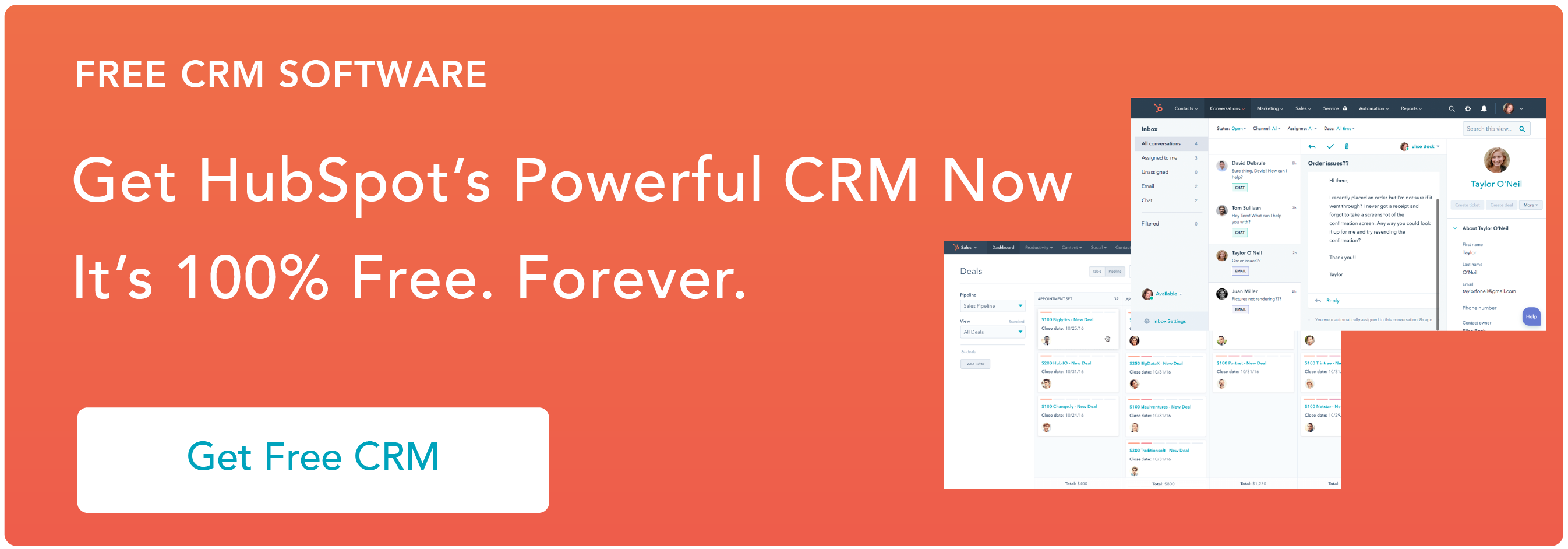What type of CRM software is right for your business? Businesses use customer relationship management software (CRM) to manage their relationships and interactions with prospects and customers (as well as the data that results from those relationships and interactions). A CRM can help any business improve its customer experience and the buyer's journey.

But not all CRMs deliver the same functionality. In general, they fall into one (or more) of the following types: Operational, analytical, or collaborative CRMs. Here’s a look at how they work and what they offer to help you find the best-fit CRM for your business.
Types of CRM
- Operational CRMs: Designed to simplify and streamline processes.
- Analytical CRMs: Designed to gather and analyze customer data.
- Collaborative CRMs: Designed to combine marketing, sales, and service data.
 Example of Operational CRM: HubSpot
Example of Operational CRM: HubSpot
Operational CRM solutions such as HubSpot offer ways to automate key processes such as marketing, sales, and service to improve the customer experience and drive conversions. We’ll talk more about this below.
Example of Analytical CRM: Zoho
Analytics CRM tools such as Zoho provide data warehousing, data mining, and online analytical processing (OLAP) tools to provide actionable customer insights.
Example of Collaborative CRM: Copper
Collaborative CRMs such as Copper deliver interaction and channel management to help understand the customer journey from initial contact to conversion.
Let’s explore the differences in detail between the three types of CRMs on the market — and why you might choose one over another.
Operational CRM
An operational CRM streamlines and simplifies an organization’s main business processes. In doing so, the tool can help companies generate leads, convert those leads into contacts, and provide the service infrastructure necessary to delight and retain customers.
What does an operational CRM typically support? Three main functions stand out.
1. Marketing Automation
Operational CRMs simplify and streamline time-consuming and manual tasks for marketers with the help of marketing automation. They automate tedious responsibilities like coordinating email campaigns, distributing content offers, and reaching out to contacts at scale.
Some CRMs can also deliver marketing analytics, track the ROI of online ads, and offer companies deep insight into individual leads. Some can even help businesses with more challenging, specialized marketing practices like SEO and blogging.
2. Sales Automation
Sales automation is meant to streamline a company’s sales process, enabling reps to spend more time interacting with prospects and bringing customers on-board.
Sales automation generally includes processes like email scheduling for leads, tools that enable prospects to schedule meetings with reps, and features to track sales calls.
Many operational CRMs also make life easier for sales reps by enabling workflows that allow them to easily and automatically rotate leads, delegate contacts, and create deals and tasks. Additionally, operational CRMs often offer features like sales record creation, better sales record visibility, and simpler lead prioritization.
3. Service Automation
Service automation is the final piece of the operational CRM puzzle. Its purpose is to help a company create an extraordinary experience for customers, keep them loyal, and encourage them to promote the company brand.
Service automation almost always sets a framework for one-on-one correspondence between service reps and customers. This may include things like setting up inboxes that aggregate customer emails or coordinating live chats and setting up chatbots.
Service automation also provides ways to delegate service tasks to reps via ticketing systems. Additional features such as a knowledge base or FAQ pages are also commonly associated with service automation.
Who should use an operational CRM?
Businesses with more linear sales processes will usually get the most out of operational CRMs. SMBs can get a lot out of these platforms, but that’s not to say that operational CRMs are specific to their needs. Even larger enterprise companies can benefit from using this kind of software.
Ultimately, if your company is trying to automate its workflow and take the human element out of the more monotonous, administrative side of your business, an operational CRM is the way to go.
Operational CRM System Example: Hubspot

HubSpot is an all-in-one CRM platform meant to align internal teams, pull meaningful insights, and report on growth opportunities. It does this by combining Marketing Hub, Sales Hub, Service Hub, and CMS Hub, along with hundreds of available integrations, to facilitate marketing, sales, and service processes.
HubSpot automates manual tasks (data entry, data sync, and contact data updates) and helps you create an experience and buyer's journey that your customers will love by centering your entire business around your customers.
HubSpot is easy to use and syncs all interactions your team has with leads and customers to that individual's timeline to maintain organized and accurate contact records for all of your internal team members to access and reference.
- Price: Free forever; $45/ mo, Starter; $450/ mo Professional; $1,200/ mo, Enterprise
- Best for: Any scaling businesses, from SMB to enterprise, and any team, including marketing, sales, customer service, operations, or C-suite.
- Key features: HubSpot CRM offers everything in one place to help your team make the most of process automation and system integration. Try it for free to see how it fits your business.
Analytical CRM
Analytical CRMs rely on data gathering and analysis to help companies better serve their customers — some examples of this information are customer preferences, behaviors, and contact information.
Companies can then leverage the data they’ve collected for better sales efforts, targeted marketing campaigns, and personalized customer support. Generally speaking, the most crucial components of an analytical CRM are data warehousing, data mining, and OLAP tools.
1. Data Warehousing
A data warehouse is a type of database incorporated into many analytical CRMs. It provides one of the most effective systems analysts can use to collect, integrate, and prepare customer data for analysis.
A data warehouse stores current and historical data in a single place and makes processes like data extraction and conducting data analysis easier than in more conventional databases.
2. Data Mining
The next component of an analytical CRM is data mining — a catch-all term for the process of discovering patterns in large data sets.
Analytical CRMs use data mining techniques to track information and data trends relevant to customer interests. This allows them to offer a better picture of a company’s customer lifecycle: a process that encompasses customer identification, attraction, retention, and development.
3. OLAP Tools
The third component of your typical analytical CRM is Online Analytical Processing (OLAP) tools. It’s a category of tools used to analyze data stored in databases. These tools are used to evaluate multidimensional data from multiple perspectives.
For example, a business may want to analyze how customers are interacting with its website. It has access to data about the online features customers are using, customers’ locations, and when they’re logging on. Having a comprehensive picture of this data could give salespeople insight into how, where, and when they should be reaching out to prospects.
Instead of analyzing each of those dimensions individually, OLAP tools enable that business to conduct an analysis on all of them simultaneously. OLAP solutions also let businesses see how customers in specific regions are interacting with their website over specific time frames.
Ultimately, OLAP tools are what an analytical CRM uses to validate hypotheses that may have been derived from information accrued by its other components.
In the example provided above, the other parts of the CRM would have gathered the data on how, when, and where customers are interacting with the site. Its OLAP tools would have clarified and applied that information, giving that business a better idea of how to conduct its sales, marketing, and service efforts.
Who should use an analytical CRM?
Analytical CRMs are best for businesses looking to leverage data to get a picture of how their customers operate.
If you’re interested, it also wouldn’t hurt to have an employee — or a few — at your company who's willing to make a conscious effort to learn some pretty technical software. Analytical CRMs aren’t necessarily difficult to use, but they take a bit more work to figure out.
Analytical CRM System Example: Zoho Analytics

Zoho Analytics gives you real-time analytics to help inform smarter business decisions. The software allows your data to transform huge amounts of raw data into actionable reports and dashboards. These capabilities can enable you to better track key performance indicators (KPIs) such as number of won deals and customers.
- Price: $22/ mo, Basic; $45/ mo, Standard; $112/ mo, Premium; $445/ mo Enterprise
- Best for: Businesses looking to improve their data analysis and reporting capabilities.
- Key features: Zoho is all about delivering real-time data to your CRM dashboard so your team can make better decisions right now and drive long-term sales and marketing strategies.
Collaborative CRM
A collaborative CRM brings together a company’s marketing, sales, and service data to improve synchronicity within the business and give each department a better understanding of their customers' needs, wants, and interests.
A collaborative CRM has two key components — interaction management and channel management.
1. Interaction Management
Interaction management is a process that tracks every interaction between a business and its customers — whether through email, social media, face-to-face interactions, phone calls, or other communication channels.
Interaction management allows a company to keep a log of these kinds of correspondence, as well as team notes about them. Different business units can then share this information across the organization.
2. Channel Management
Channel management takes interaction management a step further. It’s the process of using the information gathered and analyzed during interaction management to identify and, ultimately, pursue the communication channels that best suit customer preferences.
Should your company’s customer service unit communicate primarily via email or chat? Should your sales team make a point of pursuing one-on-one meetings or phone calls with prospects? These are the kinds of questions that channel management is designed to answer.
Who should use a collaborative CRM?
Businesses that are spread across multiple physical locations or have many teams stand to gain a lot from collaborative CRMs’ emphasis on business unit synchronicity.
The same goes for companies that rely heavily on cross-department communication. It goes without saying, but a collaborative CRM won’t be a good fit for any company not comfortable with customer information being shared liberally throughout the organization.
Collaborative CRM System Example: Copper

With Copper, all your customer data is stored in one place, allowing everyone across your organization to be in the loop about any customer interaction or deal. The platform’s user-friendly interface also features custom pipelines and dashboards. Copper is a good choice for small businesses looking for a simple, straightforward CRM that integrates seamlessly with Google Workspace.
- Price: $25/ mo, Basic; $59/ mo, Professional; $119/ mo, Business
- Best for: Small businesses that place an emphasis on collaboration and are interested in a CRM with a user-friendly interface.
- Key features: Copper offers a simple and straightforward way to store and share customer data across your organization. Integration with Google Workspace is also a plus to streamline operations.
Operational, Analytical, or Collaborative CRM?
Each type of CRM has its own benefits, but it’s important to recognize which kind of CRM best suits your needs and make your decision with that in mind.
If you’re looking to streamline your sales, marketing, and customer service, opt for operational. If you're looking to use hard data to better understand your customers, prioritizing analytical may be the way to go. And if you want to make business synchronicity and collaboration your main priorities, consider collaborative CRMs.
Editor's note: This post was originally published in December, 2019 and has been updated for comprehensiveness.








![15 Best CRMs for Small Businesses in 2024 [+ Why You Need One]](https://www.hubspot.com/hubfs/all-in-one-crm_5.webp)


